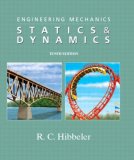Author's Homepage: R. C. Hibbeler
Chapter 7: Internal Forces
"The design of any structural or mechanical member requires an investigation of the loading acting within the member in order to be sure that materials can resist this loading. These internal loadings can be determined by using the method of sections. To illustrate the procedure, consider the simply supported beam shown in Fig. 7-1a, which is subject to the forces F1 and F2 and the support reactions Ax, Ay, and By, Fig 7-1b. If the internal loadings are acting on the cross section at C are to be determined, then an imaginary section is passed through the beam, cutting it into two segments. By doing this the internal loadings at the section become external on the free-body diagram of each segment, Fig. 7-1c. Since both segments (AC and CB) were in equilibrium before the beam was sectioned, equilibrium of each segment is maintained provided rectangular force components Nc and Vc and a resultant couple moment Mc are developed at the section. Note that these loadings must be equal in magnitude and
opposite in direction on each of the segments (Newton’s third law). The magnitude of each of these loading can now be determined by applying the three equations of equilibrium to either segment AC or CB. A direction solution for Nc is obtained by applying sumFx = 0; Vc is obtained directly from sumFy = 0; and Mc is determined by summing moments about point C, sumMc = 0, in order to eliminate the moments of the unknowns Nc and Vc."



 or by typing Shift Enter.
or by typing Shift Enter.